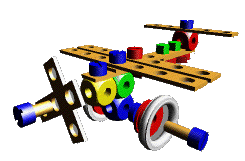Universität Bielefeld - Sonderforschungsbereich 360
The Structure of Task-oriented Dialogue and
the Introduction of New Objects
Hannes Rieser
Introduction
The following paper deals with two topics, the structure of task-oriented
dialogue and the introduction of new objects into dialogue by one of the
agents. The discusion of the structure of task-oriented dialogue is based on a
corpus of dialogues (transcripts, speech, video-films of agents' actions,
eye-movement data, see Corpus; Clermont et al. (1995); Pomplun et al.
(1998)) based on the construction of a little toy-airplane (see Fig. 1) and
tries to take account of what the data show, irrespective of idealisations
which might them make fit smugly into one of the currently favoured approaches
to dialogue. This opens up a new perspectiv on the ways agents use to organise
the information flow. Above all, the role of coordination and the evolution of
common ground for the step-by-step progress of dialogues is worked out. Common
ground is anchored in the dialogue situation. Different settings for
task-oriented dialogues, especially those without visual contact between the
agents show that common ground is something actively worked at. About all it
is based on mutual beliefs having high plausibility for the agents. Looked at
from the empirical side, common ground has to keep track of expressions,
matters of reference and interpretation, properties of situations, actions
done, and the history of the verbal exchanges carried out. Ideally, all these
aspects should go into the set up of dialogue models.

Figure 1: Toy-airplane
Empirical data clearly shows that the rise of beliefs and the agents'
temporalily maintaining them is a central mechanism for the progress of a
dialogue, determining e.g. next contributions. This holds good for the agents'
introduction of new objects into dialogue as well. Agents have to be sure
that objects have been introduced, especially in non-face-to-face conditions,
before they can anaphorically refer to them. Therefore they spend a lot of
energy on reliable object introduction and use elaborate techniques to
heighten chances of success. This indicates that theories of anaphora in
dialogue have to be sensitive to belief formation and common ground evaluation.
Postscript-File (~439 k)
Anke Weinberger, 2001-01-31, 2001-02-16

